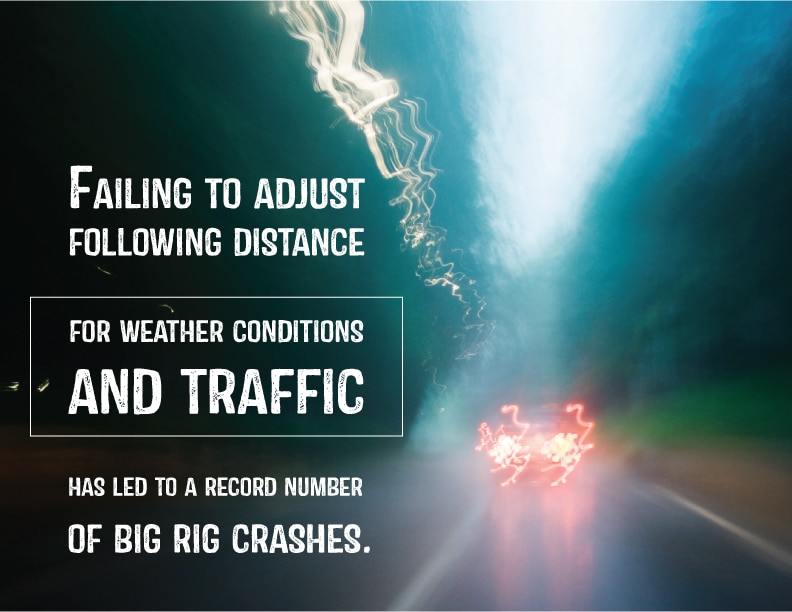
 Request FREE consultation - 1866-758-4529
Request FREE consultation - 1866-758-4529 
Many truck accidents happen simply because the truck driver was following too closely to the traffic in front of them.
A large percentage of semi-truck accidents occur because the truck driver fails to maintain a safe following distance, given the conditions on the roadway. It is no secret that 18-wheelers take much longer to stop than passenger cars. For that reason, semi-trucks or tractor-trailers should follow a safe distance between the big rig and the traffic ahead. At highway speeds, the big truck will take approximately one-third longer to come to a stop than a car. This leads to rear-end crashes.
The problem is heightened when weather conditions or road conditions are adverse.
The Federal Motor Carrier Safety Regulations under Section 392.14 provide that a commercial motor vehicle shall be driven with extreme caution when confronted with adverse conditions such as ice, fog, mist, or rain that adversely affect visibility or traction. The regulations also require a truck driver to reduce their speed when confronted with adverse conditions that affect visibility or traction.
A prudent trucker should operate their vehicle to allow a sufficient, safe following distance between the vehicle in front of the truck to allow the truck to come to a safe stop without impacting the vehicle in front of them should an emergency develop. In other words, when you know your truck takes much longer to stop than the vehicles in front of you, you should allow extra distance between the vehicles.
Nevertheless, between driving too fast in adverse conditions and following too closely to the vehicles in front of them, a record number of truck accidents have resulted in serious injuries to the occupants of vehicles in front of big rigs. Stopping distance includes reaction time for the driver to perceive the need to stop and apply the brakes. The time it takes for the brakes to be applied to the time the truck comes to a complete stop is known as the braking distance.
Braking distance has many variables, which include the makeup of the highway, factors involving the tire, such as tread, the weight of the vehicle, the condition of the brakes, and weather, such as rain, ice, or snow, which can make the roadway more slippery and adversely affect stopping distance.
Texas requires that drivers maintain an “assured clear distance”. However, there is no set distance that drivers must allow for the vehicles in front of them. The law intends to allow sufficient stopping time to avoid rear-ending another vehicle.
The Texas Department of Transportation recommends a minimum of two seconds of distance between vehicles traveling at 30 mph or less and 4 seconds of cushion for vehicles traveling at higher speeds. In the congested traffic of Houston, that is not always possible.
However, whatever is a safe distance for a passenger car is a much greater distance for a tractor-trailer or 18-wheeler. Large trucks take 20 to 40% longer to stop under the same conditions as a passenger car. Therefore, large trucks must allow a greater distance between themselves and other vehicles in front of them.
Call Us for a No Obligation Consultation Toll-Free at 1-866-758-4529
Truck accident attorney in Houston, TX
Related Resources:
Rear End Truck Accident Lawyer in Houston
Braking distance of semi trucks
What You Need to Know About an 18-Wheeler Stopping Distance
Stopping Distance is a Major Factor in Big Rig Rear-End Collisions
Why Truck Drivers Must Allow Greater Cushions of Safety